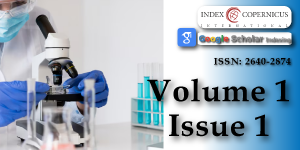Hypernatremia and central Diabetes Insipidus following Neurosurgical procedure of Trauma
Main Article Content
Article Details
Copyright (c) 2017 Magbri A, et al.

This work is licensed under a Creative Commons Attribution 4.0 International License.
Palevsky PM. Hypernatremia. Semin Nephrol. 1998; 18: 20-30. Ref.: https://goo.gl/qgUvGE
Hoefer D, Ruttmann-Ulmer E, Smiths JM, Devries E, Antretter H, et al. Donor hypo-and hypernatremia are predictors for increased 1-year mortality after cardiac transplantation. Transpl Int. 2010; 23: 589-593. Ref.: https://goo.gl/9Eh97O
Lin JJ, Lin KL, Hsia SH, Wu CT, Wang HS, et al. Combined central diabetes insipidus and cerebral salt wasting syndrome in children. Pediatr Neurol. 2009; 40: 84-87. Ref.: https://goo.gl/gJxIgv
Rose BD, Post TW. Clinical physiology of acid-base and electrolyte disorders, 5th ed, McGraw-Hill. 2001: 751. Ref.: https://goo.gl/4D1Vmk
Kimmel DW, O’Neill BP. Systemic cancer presenting as diabetes insipidus. Clinical and radiological features of 11 patients with a review of metastatic-induced diabetes insipidus. Cancer. 1983; 52: 2355-2358. Ref.: https://goo.gl/k8qCb0
Maghnie M, Cosi G, Genovese E, Manca-Bitti ML, Cohen A, et al. Central diabetes insipidus in children and young adults. N Engl J Med. 2000; 343: 998-1007. Ref.: https://goo.gl/zWlTxP
Grois N, Fahrner B, Arceci RJ, Henter JI, McClain K, et al. Central nervous system disease in Langerhans cell histiocytosis. J Pediatric. 2010; 156: 873-881. Ref.: https://goo.gl/wRPoBK
Werny D, Elfers C, Perez FA, Pihoker C, Roth CL, et al. Pediatric central diabetes insipidus: Brain malformations are common and few patients have idiopathic disease. J Clin Endocrinol Metab. 2015; 100: 3074-3080. Ref.: https://goo.gl/uqxbcH
Brewster UC, Hayslett JP. Diabetes insipidus in the third trimester of pregnancy. Obstet Gynecol. 2005; 105: 1173-1176. Ref.: https://goo.gl/bNzs2w
Lindheimer MD. Polyuria and pregnancy: its cause, its danger. Obstet Gynecol. 2005; 105: 1171-1172. Ref.: https://goo.gl/ikaGGs
Seckl J, Dunger D. Postoperative diabetes insipidus. BMJ. 1989; 298: 2-3. Ref.: https://goo.gl/A5ZgkU
Nemergut EC, Zuo Z, Jane JA Jr, Laws ER Jr. Predictors of diabetes insipidus after trans-sphenoidal surgery: a review of 881 patients. J Neurosurg. 2005; 103: 448-454. Ref.: https://goo.gl/7LU35X
Ghirardello S, Hopper N, Albanese A, Maghnie M. Diabetes insipidus in craniopharyngeoma: postoperative management of water and electrolyte disorders. J Pediatr Endocrinol Metab. 2006; 19: 413-421. Ref.: https://goo.gl/bLYq92
Hadjizacharia P, Beale EO, Inaba K, Chan LS, Demetriades D. Acute diabetes insipidus in severe head injury: a prospective study. J Am Coll Surg. 2008; 207: 477-484. Ref.: https://goo.gl/p8agfR
Seckl JR, Dunger DB, Bevan JS, Nakasu Y, Chowdrey C, et al. Vasopressin antagonist in early postoperative diabetes insipidus. Lancet. 1990; 335: 1353-1356. Ref.: https://goo.gl/VPJ4Ov
Sigounas DG, Sharpless JL, Cheng DM, Johnson TG, Senior BA, et al. Predictors and incidence of central diabetes insipidus after endoscopic pituitary surgery. Neurosurgery. 2008; 62: 71-78. Ref.: https://goo.gl/k4x1eD
Hensen J, Henig A, Fahlbusch R, Martin Meyer, Markus Boehnert, et al. Prevalence, predictors, and patterns of postoperative polyuria and hyponatremia in the immediate course after trans-sphenoidal surgery for pituitary adenomas. Cli Endocrinol. 1999; 50: 431-439. Ref.: https://goo.gl/bpPs01
Hoorn EJ, Ziestse R. Water balance disorders after neurosurgery: the triphasic response revisited. NDT Plus. 2010; 3: 42-44. Ref.: https://goo.gl/1m0pA6
Loh JA, Verbalis JG. Diabetes insipidus as a complication after pituitary surgery. Nat Clin Pract Endocrinol Metab. 2007; 3: 489-494. Ref.: https://goo.gl/xUq3Cu
Lipsett MB, Maclean JP, West CD, Li MC, Pearson OH. An analysis of the polyuria induced by hypophysectomy in man. J Clin Endocrinol Metab 1956; 16: 183-195. Ref.: https://goo.gl/mu8tfE
Crowley RK, Sherlock M, Agha A, Smith D, Thompson CJ. Clinical insights into adepsic diabetes insipidus: A large case series. Clin Endocrinol. 2007; 66: 475-482. Ref.: https://goo.gl/fQZqhy
Mizobata Y, Yokota J, Matsuoka T, Horikawa H, Nakai K, et al. Volume supplementation with iso-sodium solution prevents hypernatremia after head injury. J Trauma. 2001; 50: 871-877. Ref.: https://goo.gl/XkSqtI
Bajwa SJ, Kulshrestha A. Renal endocrine manifestations during polytrauma: A cause of concern for the anesthesiologist. Indian J Endocrinol Metab. 2012; 16: 252-257. Ref.: https://goo.gl/y0bjuU
Tisdall M, Crocker M, Watkiss J, Smith M. Disturbances of sodium in critically ill neurologic patients: A clinical review. J Neurosurg Anesthesiol. 2006; 18: 57-63. Ref.: https://goo.gl/Sco7Y7

